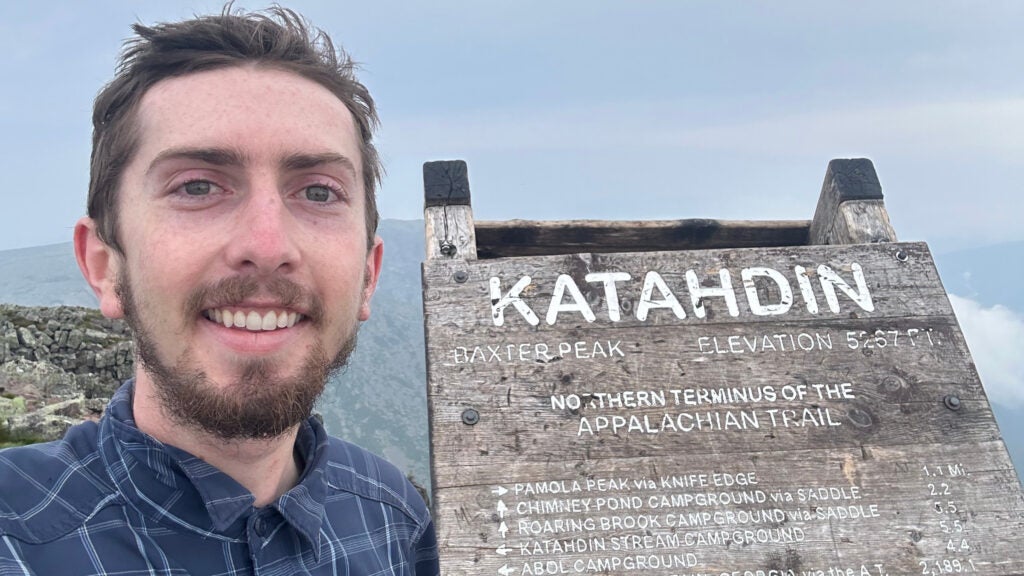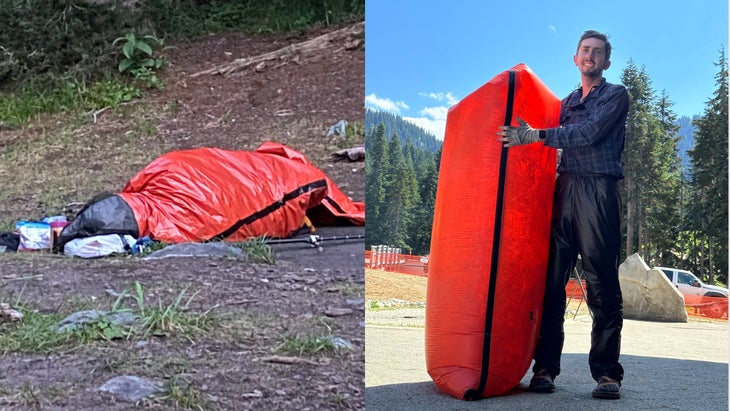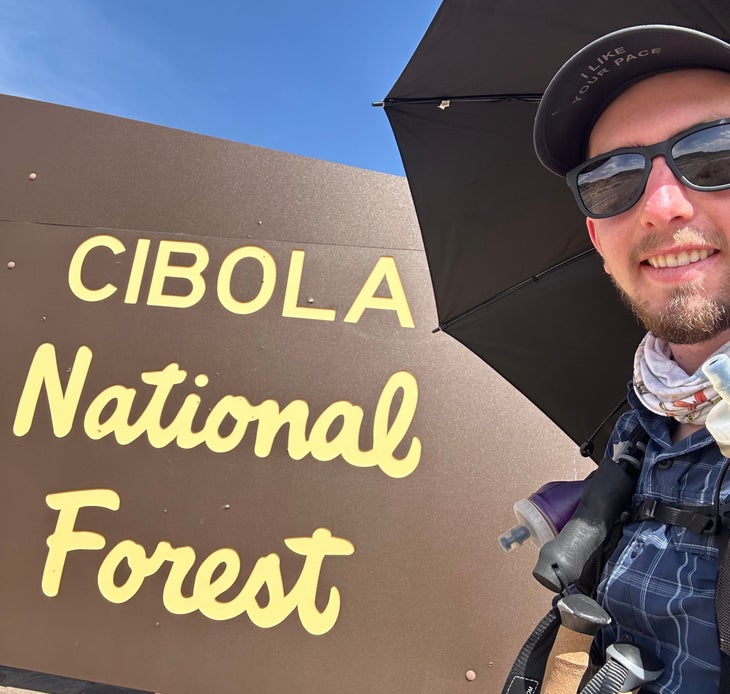



Sam Carter needed an urgent favor his first night on the Pacific Crest Trail: to borrow his dad’s Patagonia fleece.
It was mid-July, just below the Washington-Canada border, high among the North Cascades. Carter was more than 3,000 miles into the Calendar Year Triple Crown—that is, hiking the Pacific Crest, Continental Divide, and Appalachian Trails in a single year, an endurance feat so extreme less than 20 people have ever finished. In only five months, Carter had completed the AT, raced through more than 700 miles across New Mexico on the CDT, trekked much of Southern California on the PCT, and taken three weeks off to visit his sister in Japan. He had a real chance to join thru-hiking’s most rarefied ranks. But without a tent, a sleeping bag, a sleeping pad, or any substantial layers aside from what we wore, he couldn’t sleep through that Washington cold for all the shivering. Carter’s father, Brian, who had joined his only son for a few days of hiking, tossed Carter his jacket from his own tent.
Carter did not keep the jacket when Brian left. Rather, he reconsidered the way he slept on trail in the $20 emergency shelter he had purchased on Amazon just before reaching Washington: He would dig a hole in the dirt to cradle his hip, curl into the fetal position, and rest on that bivvy. When it got too cold, he climbed inside; when it became too wet with breath, he turned it inside out and tried again. When both sides were saturated, he simply got up and started walking, no matter the time.
“I would wake up drenched every morning at 4 a.m., soaking in the bag and freezing my butt off,” says Carter, 21, beaming beneath the fluorescent lights of his office at a 3D printing workshop in Carlsbad, California. “I realized I have to walk or, like, die. I learned that it was amazing how the body could produce its own heat when it needed to.”
Carter did not complete the Calendar-Year Triple Crown in 2023, bailing from the CDT in northern Wyoming in October. More than 2,000 miles short of the goal, he was waylaid by a combination of forest fires, freezing temperatures, and family vacations. But in the distance he did travel, Carter successfully pushed the limits of ultralight backpacking, finding ways to survive and advance despite an astonishingly slim base weight of 2.67 pounds, a little more than a tenth of the modern thru-hiker’s average. His monastic approach to minimalism raises complicated questions about safety, danger, and personal responsibility in the ultralight foot race.
“We asked that he check in with us every night around bedtime,” says Brian, who gave his son the trail name “Shade” during some of their earlier backpacking adventures together. “But, you know, his risk-tasking exceeded what I thought he would do. It was the horizontal equivalent of free soloing.”

When Carter was 13, he became tantalized by a statistic he heard in a lecture given by a long-distance backpacker: More people had walked on the moon (12) than had finished the Calendar-Year Triple Crown. As he and his dad hiked in the Sierra and Southern California, climbed in gyms, and attended wilderness first-aid workshops together, that fact stuck with him like a coal waiting to be tended. Early in 2023, it finally caught flame when he saw videos of the charismatic 2022 Calendar-Year Triple Crowner Jack “Quadzilla” Jones. Fresh out of high school, Carter, obsessed with robotics since age 12, was working almost 80 hours a week at his 3D-printing post.
“I was getting so burnt out,” Carter says. “I just had to make a change, and that was the hardest part.”
A month after Carter made the decision to thru-hike three trails in a single year, he was atop Springer Mountain in Georgia, at the AT’s southern terminus. Where the half-dozen others attempting the Calendar-Year Triple Crown last year had mostly planned or trained for months, Carter had given himself only weeks. There were consequences: Already scrawny, he dropped eight pounds in his first week. He lost his voice from yelling at black bears. By the time he made it out of Tennessee, the big toe of his left foot had become infected, a gnarly ingrown nail making each step feel like a new stab wound.
The stuff inside his Pa’lante Joey had always been modest—a weight of around 12 pounds, including a 20-degree Enlightened Equipment quilt and a tiny Zpacks tarp. But as he struggled with pain, even taking two days off to begin a double round of antibiotics, he began shedding items, first ditching his sleeping pad to rest directly on the dirt and then opting for a Gregory backpack with just two-thirds of his original capacity. “I tried to solve the problem by making my pack lighter,” he says. “I couldn’t carry weight at all, not really walking on my big toe. But I was going to keep hiking.”
Inspired by ultralight architect Ray Jardine and his own increased speed, these reductions became an obsession for Carter, shedding grams as he made miles. By the time he began the Pacific Crest Trail alongside his dad in Washington in July, he realized a daypack available through Amazon for $18.99 was essentially the same thing as his Gregory, but rendered in lighter fabric. He made the switch. The cumulative weight of his Big Three—that is, his backpack, the tarp he did not carry, and the sleeping bag that he had swapped for an emergency shelter used as a bivy sack—shrank to just more than a pound. When the Amazon pack broke, he shifted to an even smaller running vest.
With his phone, a charger, some cables, and a first-aid kit so small it teases the limits of the word “kit,” Carter ultimately topped out at less than three pounds, before stuffing any available space with Reese’s peanut butter cups, tortillas, and anything else he didn’t have to cook. He switched from shoes to sandals and used his orange backpack as a de facto sleeping pad; if it didn’t keep him much warmer, then at least he was a little less dirty.

When Nick Fowler first spotted that orange backpack as Carter rested on a fallen tree somewhere near Washington’s commanding Glacier Peak, he assumed Carter was a dayhiker, simply enjoying an out-and-back from his car. It was Fowler’s third day on his record-breaking Fastest Known Time attempt along the PCT.
“I’m fresh, so I’m charging up this hill,” Fowler remembers. “The next thing I know, he’s keeping up with me, and I’m going faster than normal to get away from him, so I can just be by myself. Eventually, he makes the comment, ‘Dude, you’re in shape.’”
Each on their respective record quests, the pair hiked together that day for 34 miles, Carter often stopping with Fowler as he struggled through nausea early in his effort. Fowler was gobsmacked to learn that Carter was not only a thru-hiker but was pursuing the Calendar-Year Triple Crown. Fowler’s video of Carter bounding over fallen trees as he explained his unorthodox setup went hiker-viral.
“I was inspired,” admits Fowler, whose 7.5-pound baseweight was nearly three times that of Carter’s. “I like my comfort, but I asked him a lot of questions because I was trying to think: Is this something I could potentially learn from? He’d already done the Appalachian Trail this way, and he was in the middle of the Glacier Peak Wilderness, one of the most remote areas in the country. He was fine. He was getting away with it.”
Carter knows that “getting away with it” is an apt summary of his experience, and that he was, as Instagram commenters and even fellow hikers often let him know, “a search-and-rescue nightmare waiting to happen.” But he does not have a death wish, he says softly, and self-rescue was a top priority—that is, recognizing signs he was in trouble with weather or food and adjusting as needed to get himself off trail and to safety. He carried a Garmin inReach Mini 2 (nearly a tenth of his base weight, mind you) but only used it to let his parents know he was safe each night.
Carter’s strategy, of course, was not for the faint of heart, the weak of constitution, or, one could argue, the adherents of logic. There were nights he hunkered deep beneath trees to stay as dry as possible, mornings where his frozen fingers couldn’t even open his backpack. When his battery bank broke, he asked strangers on trail about upcoming water sources and food options. But he found out how much he could take by discovering how little he could carry and still keep going.
“If I didn’t have the ability to say, ‘What did I not use in my pack?’ and take it out, or if I didn’t have the ability to get better, it wouldn’t have been as fun,” Carter says. “What was fun about these trails was my ability to get better. That’s what I tried to do out there.”
From 2024

